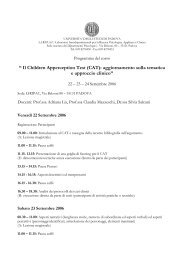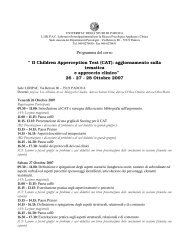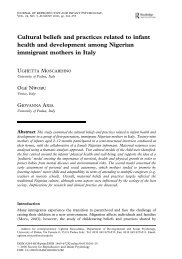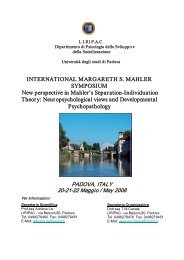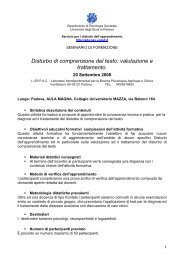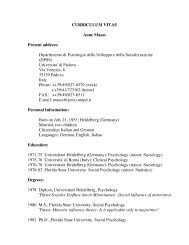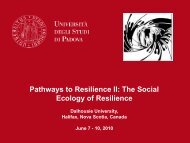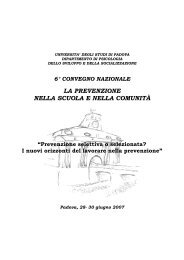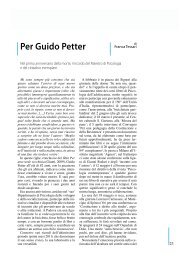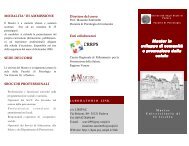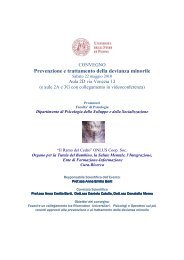Social cognition and moral cognition in bullying: What's ... - DPSS
Social cognition and moral cognition in bullying: What's ... - DPSS
Social cognition and moral cognition in bullying: What's ... - DPSS
You also want an ePaper? Increase the reach of your titles
YUMPU automatically turns print PDFs into web optimized ePapers that Google loves.
Different studies showed a positive relation between aggressive behavior <strong>and</strong> the<br />
activation of one or more of these mechanisms <strong>in</strong> both adults <strong>and</strong> children (B<strong>and</strong>ura,<br />
Barbaranelli, Caprara, & Pastorelli, 1996; Caprara, Barbaranelli, & B<strong>and</strong>ura, 1995;<br />
Caprara, Barbaranelli, Vic<strong>in</strong>o, & B<strong>and</strong>ura, 1996; Yadava, Sharma, & G<strong>and</strong>hi, 2001). In<br />
particular, Caprara <strong>and</strong> colleagues (1995) confirmed the strong l<strong>in</strong>k between <strong>moral</strong><br />
disengagement <strong>and</strong> physical <strong>and</strong> verbal aggression, both self- <strong>and</strong> peer-evaluated,<br />
especially <strong>in</strong> male children. More recently, B<strong>and</strong>ura, Caprara, Barbaranelli, Pastorelli,<br />
<strong>and</strong> Regalia (2001) have replicated these results. They found a positive relation between<br />
<strong>moral</strong> disengagement <strong>and</strong> transgressive behavior, <strong>and</strong> a negative relation between <strong>moral</strong><br />
disengagement <strong>and</strong> self-regulatory efficacy <strong>and</strong> prosocial behavior.<br />
The above mentioned studies actually referred to aggressive <strong>in</strong>dividuals, but a<br />
similar pattern of data has been found <strong>in</strong> school bully<strong>in</strong>g research, as well. Bacch<strong>in</strong>i,<br />
Amodeo, Ciardi, Valerio, <strong>and</strong> Vitelli (1998) <strong>and</strong> Menes<strong>in</strong>i, Fonzi, <strong>and</strong> Vannucci (1997),<br />
for example, found that male bullies utilized the <strong>moral</strong> disengagement mechanisms more<br />
than did other peers <strong>and</strong>, most of all, they seemed to use the mechanisms of<br />
Dehumanization <strong>and</strong> Moral Justification. A confirmation of these results emerged <strong>in</strong> a<br />
cross-national study, <strong>in</strong>volv<strong>in</strong>g Italy <strong>and</strong> Spa<strong>in</strong>, conduced by Menes<strong>in</strong>i <strong>and</strong> colleagues<br />
(Menes<strong>in</strong>i, Codecasa, Benelli, & Cowie, 2003), who assessed <strong>moral</strong> reason<strong>in</strong>g of bullies,<br />
victims <strong>and</strong> children who assumed the role of the defender, us<strong>in</strong>g the Scan Bully<strong>in</strong>g test<br />
(Almeida, del Barrio, Marques, Gutierrez, & van der Meulen, 2001). These authors<br />
confirmed the tendency of bullies to show higher levels of <strong>moral</strong> disengagement, <strong>and</strong> the<br />
presence of a profile of egocentric reason<strong>in</strong>g <strong>in</strong> these pupils.<br />
8



